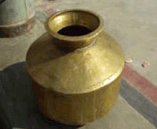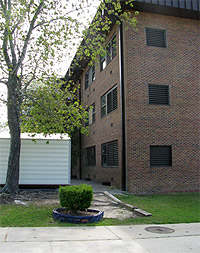Historial Uses
 Typical brass mutka from rural Rajasthan, India
Typical brass mutka from rural Rajasthan, IndiaCopper and its alloys (brasses, bronzes, copper nickels, copper nickel zincs, and others) are naturally antimicrobial materials. Man exploited the antimicrobial attributes of copper long before the nineteenth century, when Louis Pasteur developed the germ theory of disease which states that infections are caused by microbes invading the human body. The Hippocrates Collection, 460 to 380 B.C., to which the father of medicine contributed, recommends the use of copper for leg ulcers related to varicose veins. Pliny, 23 to 79 A.D., used copper oxide with honey to treat intestinal worms. The Aztecs gargled with a mixture containing copper to treat sore throats. In a laboratory study, water inoculated with the fecal indicator bacterium Escherichia coli was stored in brass water vessels traditionally used in rural India, as well as in earthenware vessels. The vessels contained distilled water or natural water from the Punjab region in rural India. No live bacteria were found in the brass vessels after 48 hours, while the water in the earthenware vessels remained contaminated. In an earlier study, brass doorknobs in a hospital showed sparse growth of pathogenic bacteria, while stainless steel doorknobs were heavily contaminated.
Today
 Fort Jackson Barracks
Fort Jackson BarracksCopper and its alloys have been show to be microbiocidal and effective in eliminating both gram-negative and gram-positive bacteria, molds, fungi and viruses, which can pollute the internal atmosphere within buildings, or result in heavy microburdens or bioloads on many touch surfaces that allow some of these pathogenic bacteria to be readily transferred from person to person, especially in hospitals and public market places.
Based on the studies evaluating room air quality currently being undertaken by the University of South Carolina on behalf of the U.S. Department of Defense, it would appear that bacteria and molds found in heating, ventilation and air conditioning systems (HVAC) can be eliminated when copper and its alloys are used in their construction, especially in ducting, heat exchangers, drip pans and drain lines, where dark and moist conditions exist. This would provide human health benefits to both military personnel living in barracks, or personnel working at medical centers and in commercial buildings (offices, hotels), by eliminating moldy smells, overcome potential sick building syndrome or even Legionnaires disease, where buildings have been unoccupied, and where the HVAC unit had not been used for some considerable period of time.
CDA-sponsored research has demonstrated the effectiveness of copper and its alloys in eliminating bacteria, molds and viruses such as MRSA, Influenza A, E.coli 0157-H7, Listeria Monocytogenes, Legionella pneumophila, Asperillus niger, among other pathogens.
Jump to: EPA Registration | Efficacy against Various Organisms | Bacteria | Viruses | Fungi | Tarnishing | References
